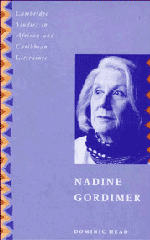Book contents
- Frontmatter
- Contents
- Preface
- List of abbreviations
- Chronology
- 1 Gordimer and South Africa: themes, issues and literary identity
- 2 The early novels: The Lying Days, A World of Strangers and Occasion for Loving
- 3 Developing narrative muscle: The Late Bourgeois World, A Guest of Honour and The Conservationist
- 4 The construction of identity: Burger's Daughter and July's People
- 5 Self-reflexive reassessments: A Sport of Nature and My Son's Story
- 6 The short stories
- 7 Conclusion. Gordimer: postmodernist?
- Notes
- Select bibliography
- Index
1 - Gordimer and South Africa: themes, issues and literary identity
Published online by Cambridge University Press: 05 July 2011
- Frontmatter
- Contents
- Preface
- List of abbreviations
- Chronology
- 1 Gordimer and South Africa: themes, issues and literary identity
- 2 The early novels: The Lying Days, A World of Strangers and Occasion for Loving
- 3 Developing narrative muscle: The Late Bourgeois World, A Guest of Honour and The Conservationist
- 4 The construction of identity: Burger's Daughter and July's People
- 5 Self-reflexive reassessments: A Sport of Nature and My Son's Story
- 6 The short stories
- 7 Conclusion. Gordimer: postmodernist?
- Notes
- Select bibliography
- Index
Summary
Nadine Gordimer, a white South African, is her country's most famous writer, and in that particular conjunction – of national identity and literary fame – lies the tension which is the determining feature of her career: her position as a consistent, and increasingly radical, critic of apartheid is a position located, to some extent, within the power-group it would challenge. Yet if there is an inevitable (unwanted) complicity for Gordimer as a white, middle-class South African citizen, it is due only to her refusal to exile herself that she has been able to articulate the nature of that complicity, and this is the focus of her extraordinary achievement: her oeuvre – the sequence of novels in particular – comprises the most significant sustained literary response to apartheid extant.
Gordimer was born on 20 November 1923 at Springs near Johannesburg, the daughter of immigrants: her mother, Nan Myers, was born in England, and her father, Isidore Gordimer, was a Jew who emigrated from Lithuania at the age of thirteen. Gordimer was brought up at Springs and attended the University of the Witwatersrand in Johannesburg for one year. Her first marriage was in 1949, and she was married again in 1954 to Reinhold Cassirer.
- Type
- Chapter
- Information
- Nadine Gordimer , pp. 1 - 33Publisher: Cambridge University PressPrint publication year: 1994



